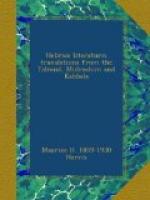Sacerdos nascitur, non fit,—a priest is born, not made, we may truly say, just altering one word of a well-known proverb. His father was a priest, and so were his forefathers as far back as the time of Aaron; his sons and his sons’ sons after him will belong to the priestly order, and so the name was far too often only the badge for exclusive and hereditary privilege. This rule, that applies to the priests, holds good also with regard to the Levites. (Berachoth, fol. 29, col. 1.)
There was a town in the land of Israel called Gophnith, where there were eighty couples of brother priests who married eighty couples of sister priestesses in one night.
Berachoth fol. 44, col. 1.
Flay a carcass and take thy fee, but say not it is humiliating because I am a priest, I am a great man.
P’sachim, fol. 113, col. 1.
Philo Judaeus, De Sac.
Honor, (p. 833), says, “The hides of the
burnt-offerings proved a rich
perquisite of the priesthood.”
The number of high priests who officiated in succession during the 410 years of the continuance of the first Temple was only eighteen, but the number who held office during the 420 years of the second Temple amounted to more than three hundred, most of them having died within a year after their entrance upon the office. The reason assigned by the Talmud for the long lives of the former and the short lives of the latter is the text given in Prov. x. 27, “The fear of the Lord prolongeth days, but the years of the wicked shall be shortened.”
Yoma, fol. 9, col. 1.
Before a priest could be admitted into active service in the Temple he had to undergo bodily inspection at the hands of the syndicate of the Sanhedrin. If they found the least defect in his body, even a mole with hair upon it, he was ordered to dress in black and be dismissed; but if he was perfectly free from blemish, he was arrayed in white, and at once introduced to his brother priests and official duties.
Ibid., fol. 19, col. 1.
The daughters of a male proselyte who has married the daughter of a female proselyte are eligible to marry priests.
Yevamoth, fol. 57, col. 1.
If thou seest an impudent priest, think not evil of him; for it is said (Hosea iv. 4), “Thy people are as they that strive with the priest” (see chap. ii. p. 25, Note c.).
Kiddushin, fol. 70, col. 2.
So long as there is a diadem on the head of the priest, there is a crown on the head of every man. Remove the diadem from the head of the high priest and you take away the crown from the head of all the people. (This is a Talmudic comment on Ezek. xxi. 31; A. Ver., 26.)
Gittin, fol. 7, col. 1.
A king shaved his head every day, a high priest did the same once a week, and an ordinary priest once a month.
Sanhedrin, fol. 22, col. 2.




